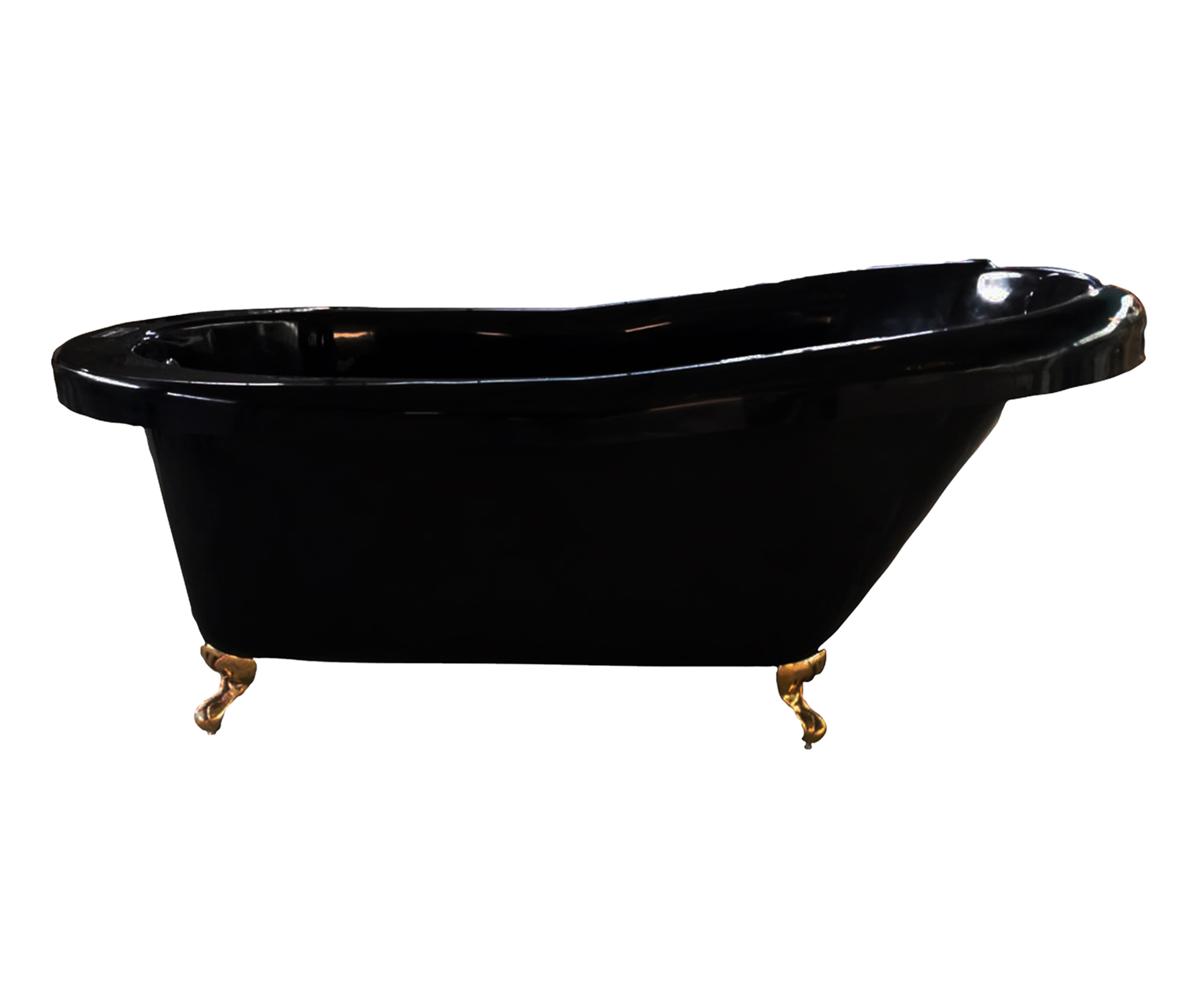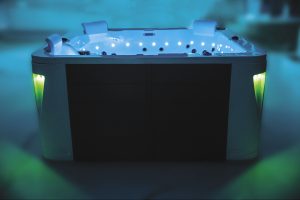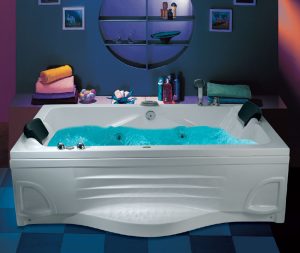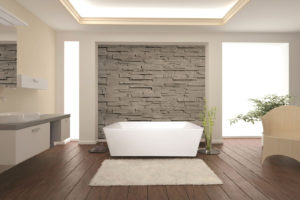Round freestanding tubs are a beautiful addition to any bathroom. They’re stylish, comfortable, and can turn your regular bathroom into a spa-like retreat. But to keep your tub looking great and working well, you need to take good care of it. In this post, we’ll show you how to clean and maintain your round freestanding tub, no matter what it’s made of. We’ll cover everything from daily care to deep cleaning, so you can enjoy your tub for years to come.
Why Tub Material Matters?
Before we jump into cleaning tips, let’s talk about what your tub is made of. This is important because different materials need different care. Most round freestanding tubs are made from acrylic, cast iron with enamel coating, stone (like marble or granite), copper, or composite materials.
Acrylic tubs are popular because they’re lightweight and keep water warm for a long time. They’re also pretty easy to clean, but you need to be careful not to scratch them. Cast iron tubs with enamel coating are super durable and great at keeping water hot. They can handle stronger cleaners, but you need to watch out for chips in the enamel. Stone tubs look amazing and are very sturdy, but they need special care to keep them looking good. Copper tubs are unique and naturally resist bacteria, but they need gentle cleaning to maintain their special patina. Composite tubs are made from a mix of materials and can look like stone, but they’re usually easier to care for.
Knowing what your tub is made of will help you choose the right cleaning products and methods. This way, you’ll keep your tub in top shape without damaging it.
Daily Tub Care: Simple Steps for a Clean Tub
Taking care of your tub every day doesn’t have to be a big chore. In fact, a few simple steps can make a big difference in keeping your tub clean and preventing buildup of soap scum and water spots. Here’s what you should do after each bath:
First, give your tub a quick rinse with clean water. This helps wash away any soap residue or bath products that might be left behind. You can use the showerhead if your tub has one, or just splash some water around with your hand. Next, grab a soft cloth or squeegee and wipe down the sides of the tub. This step is super important because it gets rid of water droplets that can leave spots or marks when they dry. Pay extra attention to any corners or edges where water tends to collect.
If you notice any soap scum or small water spots, now’s the time to deal with them. A quick wipe with a damp microfiber cloth is usually enough to take care of these before they become stubborn stains. Don’t forget about the outside of the tub too. A quick wipe down of the exterior can keep it looking shiny and prevent dust from building up.
Lastly, make sure your bathroom has good air flow. Turn on the fan or open a window after your bath. This helps dry out the tub and the whole bathroom, which can stop mold and mildew from growing. These daily habits might seem small, but they can save you a lot of scrubbing later on. Plus, you’ll always have a clean tub ready for your next relaxing soak.
Weekly Cleaning: Keeping Your Tub Sparkling
Once a week, it’s time to give your tub a more thorough cleaning. This weekly routine will keep your tub looking great and prevent buildup of tough stains. Here’s how to do it:
Start by choosing the right cleaning product for your tub. For acrylic tubs, use a mild, non-abrasive cleaner. Cast iron tubs can handle slightly stronger cleaners, but avoid anything too harsh. Stone tubs need special stone cleaners to protect their surface. For copper tubs, stick to gentle, pH-neutral soaps. Composite tubs usually do well with mild, all-purpose bathroom cleaners.
Now, let’s clean! First, remove any items from around your tub and give it a quick rinse with warm water. This gets rid of loose dirt and makes cleaning easier. Next, apply your chosen cleaner. You can use a soft sponge or cloth to spread it around. Don’t use anything scratchy like scouring pads – they can damage your tub’s surface.
For the actual scrubbing, use gentle, circular motions. Start at the top of the tub and work your way down. This way, dirty water won’t drip onto areas you’ve already cleaned. Pay extra attention to areas that tend to get dirty, like around the faucets and drain. These spots often collect soap scum and grime.
After you’ve scrubbed the whole tub, it’s time to rinse. Use plenty of clean water to wash away all the cleaner and dirt. You might need to rinse a few times to get everything off. Once you’re done rinsing, use a soft towel or squeegee to dry the tub. This prevents water spots and makes your tub shine.
Don’t forget about the outside of your tub! Wipe it down with a damp cloth and dry it off. This keeps dust and grime from building up on the exterior. By following this weekly routine, you’ll keep your tub clean and shiny, and you’ll catch any potential problems before they become big issues.
Deep Cleaning: Giving Your Tub Some Extra Love
Every month or so, your tub needs a deep clean. This is when you really get into all the nooks and crannies to remove any buildup that regular cleaning might miss. The frequency of deep cleaning depends on how often you use your tub and how hard your water is. If you have hard water or use your tub daily, you might need to deep clean more often.
For deep cleaning, you might need to use stronger products than your usual cleaners. But be careful – always choose products that are safe for your tub’s material. For acrylic tubs, you can make a paste with baking soda and water. This is great for scrubbing away tough stains without scratching. For cast iron tubs, you can use a mixture of vinegar and water to tackle soap scum and hard water stains. Stone tubs need special care – use a stone-safe cleaner and avoid anything acidic like vinegar. Copper tubs should be cleaned with a mixture of lemon juice and baking soda, which helps maintain their unique patina. For composite tubs, a mix of dish soap and warm water usually does the trick.
Start your deep clean by applying your chosen cleaner all over the tub. Let it sit for a few minutes to really work on any built-up grime. Then, use a soft sponge or cloth to scrub the entire surface. Pay extra attention to areas around the faucets, drain, and any textured parts of the tub. These areas often collect the most dirt and soap scum.
For really tough stains, you might need to repeat the process or use a specialized stain remover. Just make sure it’s safe for your tub’s material. After scrubbing, rinse the tub thoroughly with clean water. You might need to rinse several times to make sure all the cleaner is gone.
Once you’ve finished cleaning and rinsing, dry the tub completely with a soft towel. This is a good time to check for any issues like small scratches or chips. If you notice any problems, it’s best to deal with them right away to prevent them from getting worse.
Deep cleaning might take a bit more time and effort, but it’s worth it. Your tub will look amazing, and you’ll be extending its life by preventing long-term buildup and damage.
Keeping Your Tub’s Finish Looking Great
The finish of your tub is what makes it look shiny and new. Taking care of this finish is key to keeping your tub looking great for years. Different tub materials need different care, so let’s break it down:
For acrylic tubs, the main thing is to avoid scratches. Never use abrasive cleaners or scrubby sponges. Stick to soft cloths and mild cleaners. If you notice any small scratches, you can often buff them out with a special acrylic polish. For day-to-day care, a quick wipe with a soft, damp cloth is all you need.
Cast iron tubs with enamel coating are tough, but you still need to be careful. The big risks here are rust and chips in the enamel. To prevent rust, make sure to dry your tub after each use, especially around the drain and overflow. If you notice any chips in the enamel, you can buy repair kits to fix them. Don’t let chips go unfixed, as water can get under the enamel and cause more damage.
Stone tubs, like those made of marble or granite, need special care to keep their finish. These tubs should be sealed regularly to protect them from stains and etching. How often you need to seal depends on the type of stone and how much you use the tub. Generally, once a year is a good rule of thumb. Use pH-neutral cleaners made for stone to keep the finish looking great. If your stone tub starts to look dull, you can have it professionally polished to bring back its shine.
Copper tubs are unique because they develop a patina over time. This changing color is part of the charm of copper tubs. To maintain this patina, avoid harsh chemicals and stick to gentle, pH-neutral soaps. If you want to speed up the patina process, you can use a copper oxidizing solution. Some people prefer to keep their copper tubs shiny, in which case you’ll need to polish it regularly with a copper cleaner.
Composite tubs often have a gelcoat finish that gives them their smooth, shiny look. To keep this finish in good shape, avoid abrasive cleaners and scrubbers. Use mild, non-abrasive cleaners and soft cloths for cleaning. If the finish starts to look dull, you can use a special gelcoat polish to bring back the shine.
No matter what type of tub you have, if you notice the finish looking dull or see minor scratches, don’t panic. There are often simple fixes you can do at home. For small scratches on acrylic or composite tubs, you can try using a polish made for that material. For stone tubs, a stone-safe polish can help with minor dulling. If you’re not sure how to fix an issue, it’s always best to ask a professional. They can give you advice or fix the problem without risking damage to your tub.
Taking Care of Tub Hardware
Your tub isn’t just about the main bowl – it’s also got hardware like faucets, drains, and maybe an overflow cover. These parts need care too. Keeping them clean and well-maintained not only makes your tub look better, but also helps prevent leaks and other problems.
Let’s start with the faucets. These can get water spots and soap scum buildup pretty easily. To clean them, use a soft cloth and a mild cleaner. Be gentle to avoid scratching the finish. For tough buildup, you can make a paste with baking soda and water. Apply it to the faucets, let it sit for a few minutes, then wipe it off with a damp cloth. Dry the faucets thoroughly to prevent water spots.
The drain is another important part to keep clean. Hair and soap can build up here and cause clogs. Once a week, remove any visible hair or debris from the drain. You can use a drain brush to clean a little deeper. If you notice the water draining slowly, try using a mixture of baking soda and vinegar. Pour it down the drain, let it sit for about 15 minutes, then flush with hot water. This can help clear minor clogs and keep your drain flowing freely.
Don’t forget about the overflow cover. This is the little plate near the top of the tub that prevents water from spilling over if the tub gets too full. It can collect soap scum and grime. Clean it regularly with the same mild cleaner you use on the rest of the tub. Make sure to dry it well to prevent water spots.
If your tub has a handheld showerhead, clean it periodically too. Soak it in vinegar to remove mineral buildup, then rinse it thoroughly. This keeps the water flowing smoothly and prevents spraying in odd directions.
Lastly, keep an eye out for any signs of leaks or loose parts. If you notice a faucet dripping or any hardware feeling loose, it’s best to fix it right away. Small problems can turn into big ones if left alone. If you’re not comfortable fixing these issues yourself, call a plumber. Taking care of small problems early can save you from bigger, more expensive repairs down the line.
By giving some attention to your tub’s hardware, you’re not just keeping it looking good – you’re also making sure everything works properly. This care helps your whole tub last longer and function better, giving you many more years of relaxing baths.




